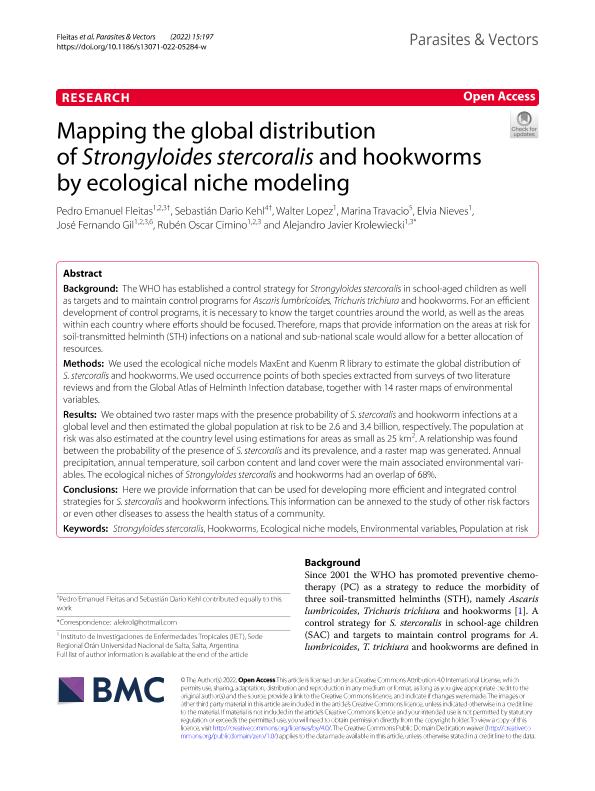Artículo
Mapping the global distribution of Strongyloides stercoralis and hookworms by ecological niche modeling
Fleitas, Pedro Emanuel ; Kehl, Sebastian Dario; López, Walter Rodrigo
; Kehl, Sebastian Dario; López, Walter Rodrigo ; Travacio, Marina; Nieves, Elvia Ester
; Travacio, Marina; Nieves, Elvia Ester ; Gil, José Fernando
; Gil, José Fernando ; Cimino, Rubén Oscar
; Cimino, Rubén Oscar ; Krolewiecki, Alejandro Javier
; Krolewiecki, Alejandro Javier
 ; Kehl, Sebastian Dario; López, Walter Rodrigo
; Kehl, Sebastian Dario; López, Walter Rodrigo ; Travacio, Marina; Nieves, Elvia Ester
; Travacio, Marina; Nieves, Elvia Ester ; Gil, José Fernando
; Gil, José Fernando ; Cimino, Rubén Oscar
; Cimino, Rubén Oscar ; Krolewiecki, Alejandro Javier
; Krolewiecki, Alejandro Javier
Fecha de publicación:
06/2022
Editorial:
BioMed Central
Revista:
Parasites and Vectors
ISSN:
1756-3305
Idioma:
Inglés
Tipo de recurso:
Artículo publicado
Clasificación temática:
Resumen
Background: The WHO has established a control strategy for Strongyloides stercoralis in school-aged children as well as targets and to maintain control programs for Ascaris lumbricoides, Trichuris trichiura and hookworms. For an efficient development of control programs, it is necessary to know the target countries around the world, as well as the areas within each country where efforts should be focused. Therefore, maps that provide information on the areas at risk for soil-transmitted helminth (STH) infections on a national and sub-national scale would allow for a better allocation of resources. Methods: We used the ecological niche models MaxEnt and Kuenm R library to estimate the global distribution of S. stercoralis and hookworms. We used occurrence points of both species extracted from surveys of two literature reviews and from the Global Atlas of Helminth Infection database, together with 14 raster maps of environmental variables. Results: We obtained two raster maps with the presence probability of S. stercoralis and hookworm infections at a global level and then estimated the global population at risk to be 2.6 and 3.4 billion, respectively. The population at risk was also estimated at the country level using estimations for areas as small as 25 km2. A relationship was found between the probability of the presence of S. stercoralis and its prevalence, and a raster map was generated. Annual precipitation, annual temperature, soil carbon content and land cover were the main associated environmental variables. The ecological niches of Strongyloides stercoralis and hookworms had an overlap of 68%. Conclusions: Here we provide information that can be used for developing more efficient and integrated control strategies for S. stercoralis and hookworm infections. This information can be annexed to the study of other risk factors or even other diseases to assess the health status of a community.
Archivos asociados
Licencia
Identificadores
Colecciones
Articulos(CCT - SALTA-JUJUY)
Articulos de CTRO.CIENTIFICO TECNOL.CONICET - SALTA-JUJUY
Articulos de CTRO.CIENTIFICO TECNOL.CONICET - SALTA-JUJUY
Articulos(INENCO)
Articulos de INST.DE INVEST.EN ENERGIA NO CONVENCIONAL
Articulos de INST.DE INVEST.EN ENERGIA NO CONVENCIONAL
Citación
Fleitas, Pedro Emanuel; Kehl, Sebastian Dario; López, Walter Rodrigo; Travacio, Marina; Nieves, Elvia Ester; et al.; Mapping the global distribution of Strongyloides stercoralis and hookworms by ecological niche modeling; BioMed Central; Parasites and Vectors; 15; 1; 6-2022; 1-12
Compartir
Altmétricas



